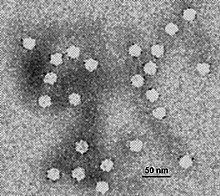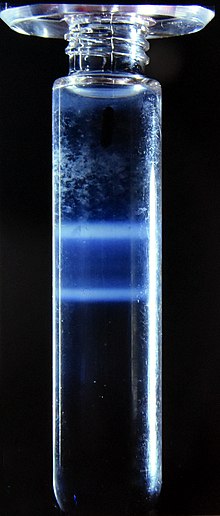
Gel electrophoresis is a method for separation and analysis of biomacromolecules and their fragments, based on their size and charge. It is used in clinical chemistry to separate proteins by charge or size and in biochemistry and molecular biology to separate a mixed population of DNA and RNA fragments by length, to estimate the size of DNA and RNA fragments or to separate proteins by charge.
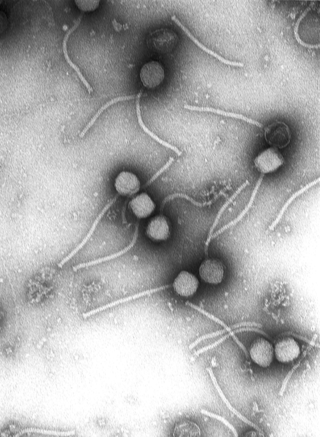
Virology is the scientific study of biological viruses. It is a subfield of microbiology that focuses on their detection, structure, classification and evolution, their methods of infection and exploitation of host cells for reproduction, their interaction with host organism physiology and immunity, the diseases they cause, the techniques to isolate and culture them, and their use in research and therapy.

A centrifuge is a device that uses centrifugal force to subject a specimen to a specified constant force, for example to separate various components of a fluid. This is achieved by spinning the fluid at high speed within a container, thereby separating fluids of different densities or liquids from solids. It works by causing denser substances and particles to move outward in the radial direction. At the same time, objects that are less dense are displaced and moved to the centre. In a laboratory centrifuge that uses sample tubes, the radial acceleration causes denser particles to settle to the bottom of the tube, while low-density substances rise to the top. A centrifuge can be a very effective filter that separates contaminants from the main body of fluid.
In chemistry, the molar mass of a chemical compound is defined as the ratio between the mass and the amount of substance of any sample of said compound. The molar mass is a bulk, not molecular, property of a substance. The molar mass is an average of many instances of the compound, which often vary in mass due to the presence of isotopes. Most commonly, the molar mass is computed from the standard atomic weights and is thus a terrestrial average and a function of the relative abundance of the isotopes of the constituent atoms on Earth. The molar mass is appropriate for converting between the mass of a substance and the amount of a substance for bulk quantities.
The Meselson–Stahl experiment is an experiment by Matthew Meselson and Franklin Stahl in 1958 which supported Watson and Crick's hypothesis that DNA replication was semiconservative. In semiconservative replication, when the double-stranded DNA helix is replicated, each of the two new double-stranded DNA helices consisted of one strand from the original helix and one newly synthesized. It has been called "the most beautiful experiment in biology." Meselson and Stahl decided the best way to trace the parent DNA would be to tag them by changing one of its atoms. Since nitrogen is present in all of the DNA bases, they generated parent DNA containing a heavier isotope of nitrogen than would be present naturally. This altered mass allowed them to determine how much of the parent DNA was present in the DNA after successive cycles of replication.

Centrifugation is a mechanical process which involves the use of the centrifugal force to separate particles from a solution according to their size, shape, density, medium viscosity and rotor speed. The denser components of the mixture migrate away from the axis of the centrifuge, while the less dense components of the mixture migrate towards the axis. Chemists and biologists may increase the effective gravitational force of the test tube so that the precipitate (pellet) will travel quickly and fully to the bottom of the tube. The remaining liquid that lies above the precipitate is called a supernatant or supernate.

In biochemistry and cell biology, differential centrifugation is a common procedure used to separate organelles and other sub-cellular particles based on their sedimentation rate. Although often applied in biological analysis, differential centrifugation is a general technique also suitable for crude purification of non-living suspended particles. In a typical case where differential centrifugation is used to analyze cell-biological phenomena, a tissue sample is first lysed to break the cell membranes and release the organelles and cytosol. The lysate is then subjected to repeated centrifugations, where particles that sediment sufficiently quickly at a given centrifugal force for a given time form a compact "pellet" at the bottom of the centrifugation tube.
Protein purification is a series of processes intended to isolate one or a few proteins from a complex mixture, usually cells, tissues or whole organisms. Protein purification is vital for the specification of the function, structure and interactions of the protein of interest. The purification process may separate the protein and non-protein parts of the mixture, and finally separate the desired protein from all other proteins. Ideally, to study a protein of interest, it must be separated from other components of the cell so that contaminants won't interfere in the examination of the protein of interest's structure and function. Separation of one protein from all others is typically the most laborious aspect of protein purification. Separation steps usually exploit differences in protein size, physico-chemical properties, binding affinity and biological activity. The pure result may be termed protein isolate.
A minisatellite is a tract of repetitive DNA in which certain DNA motifs are typically repeated two to several hundred times. Minisatellites occur at more than 1,000 locations in the human genome and they are notable for their high mutation rate and high diversity in the population. Minisatellites are prominent in the centromeres and telomeres of chromosomes, the latter protecting the chromosomes from damage. The name "satellite" refers to the early observation that centrifugation of genomic DNA in a test tube separates a prominent layer of bulk DNA from accompanying "satellite" layers of repetitive DNA. Minisatellites are small sequences of DNA that do not encode proteins but appear throughout the genome hundreds of times, with many repeated copies lying next to each other.
Satellite DNA consists of very large arrays of tandemly repeating, non-coding DNA. Satellite DNA is the main component of functional centromeres, and form the main structural constituent of heterochromatin.

Protein electrophoresis is a method for analysing the proteins in a fluid or an extract. The electrophoresis may be performed with a small volume of sample in a number of alternative ways with or without a supporting medium, namely agarose or polyacrylamide. Variants of gel electrophoresis include SDS-PAGE, free-flow electrophoresis, electrofocusing, isotachophoresis, affinity electrophoresis, immunoelectrophoresis, counterelectrophoresis, and capillary electrophoresis. Each variant has many subtypes with individual advantages and limitations. Gel electrophoresis is often performed in combination with electroblotting or immunoblotting to give additional information about a specific protein.
The first isolation of deoxyribonucleic acid (DNA) was done in 1869 by Friedrich Miescher. DNA extraction is the process of isolating DNA from the cells of an organism isolated from a sample, typically a biological sample such as blood, saliva, or tissue. It involves breaking open the cells, removing proteins and other contaminants, and purifying the DNA so that it is free of other cellular components. The purified DNA can then be used for downstream applications such as PCR, sequencing, or cloning. Currently, it is a routine procedure in molecular biology or forensic analyses.
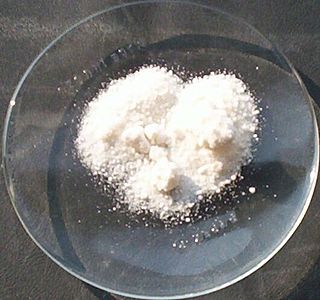
Caesium chloride or cesium chloride is the inorganic compound with the formula CsCl. This colorless salt is an important source of caesium ions in a variety of niche applications. Its crystal structure forms a major structural type where each caesium ion is coordinated by 8 chloride ions. Caesium chloride dissolves in water. CsCl changes to NaCl structure on heating. Caesium chloride occurs naturally as impurities in carnallite, sylvite and kainite. Less than 20 tonnes of CsCl is produced annually worldwide, mostly from a caesium-bearing mineral pollucite.

Molecular motors are natural (biological) or artificial molecular machines that are the essential agents of movement in living organisms. In general terms, a motor is a device that consumes energy in one form and converts it into motion or mechanical work; for example, many protein-based molecular motors harness the chemical free energy released by the hydrolysis of ATP in order to perform mechanical work. In terms of energetic efficiency, this type of motor can be superior to currently available man-made motors. One important difference between molecular motors and macroscopic motors is that molecular motors operate in the thermal bath, an environment in which the fluctuations due to thermal noise are significant.

Bisbenzimide is an organic compound used as a fluorescent stain for DNA in molecular biology applications. Several related chemical compounds are used for similar purposes and are collectively called Hoechst stains.
In genetics, an isochore is a large region of genomic DNA with a high degree of uniformity in GC content; that is, guanine (G) and cytosine (C) bases. The distribution of bases within a genome is non-random: different regions of the genome have different amounts of G-C base pairs, such that regions can be classified and identified by the proportion of G-C base pairs they contain.
Calcium chloride (CaCl2) transformation is a laboratory technique in prokaryotic (bacterial) cell biology. The addition of calcium chloride to a cell suspension promotes the binding of plasmid DNA to lipopolysaccharides (LPS). Positively charged calcium ions attract both the negatively charged DNA backbone and the negatively charged groups in the LPS inner core. The plasmid DNA can then pass into the cell upon heat shock, where chilled cells (+4 degrees Celsius) are heated to a higher temperature (+42 degrees Celsius) for a short time.
Stable-isotope probing (SIP) is a technique in microbial ecology for tracing uptake of nutrients in biogeochemical cycling by microorganisms. A substrate is enriched with a heavier stable isotope that is consumed by the organisms to be studied. Biomarkers with the heavier isotopes incorporated into them can be separated from biomarkers containing the more naturally abundant lighter isotope by isopycnic centrifugation. For example, 13CO2 can be used to find out which organisms are actively photosynthesizing or consuming new photosynthate. As the biomarker, DNA with 13C is then separated from DNA with 12C by centrifugation. Sequencing the DNA identifies which organisms were consuming existing carbohydrates and which were using carbohydrates more recently produced from photosynthesis. SIP with 18O-labeled water can be used to find out which organisms are actively growing, because oxygen from water is incorporated into DNA (and RNA) during synthesis.
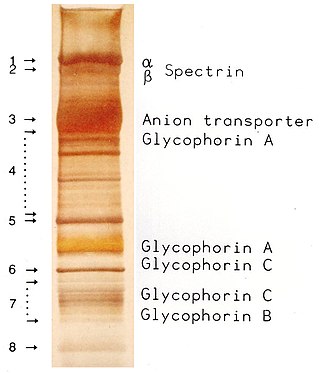
SDS-PAGE is a discontinuous electrophoretic system developed by Ulrich K. Laemmli which is commonly used as a method to separate proteins with molecular masses between 5 and 250 kDa. The combined use of sodium dodecyl sulfate and polyacrylamide gel eliminates the influence of structure and charge, and proteins are separated by differences in their size. At least up to 2012, the publication describing it was the most frequently cited paper by a single author, and the second most cited overall.

Analytical band centrifugation (ABC) (also known as analytical band ultracentrifugation, or band sedimentation-velocity), is a specialized ultracentrifugation procedure, where unlike the typical use of (boundary) sedimentation velocity analytical ultracentrifugation (SV-AUC) wherein a homogenous bulk solution is centrifuged, in ABC a thin (~15 µL, ~500 µm) sample is layered on top of a bulk solvent and then centrifuged. The method is distinguished from zone-sedimentation in that a stabilizing density gradient is self-generated during centrifugation, through the use of a higher density (than the sample) bulk "binary solvent", containing both a solvent (i.e. H2O), and a second component (small molecules, i.e. CsCl) that will sediment to form a stabilizing density gradient for the sample.
